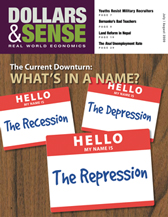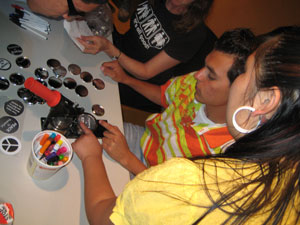Active Culture
Youth of Color Resist Military Recruiting
This article is from the July/August 2009 issue of Dollars & Sense: Real World Economics available at http://www.dollarsandsense.org

This article is from the July/August 2009 issue of Dollars & Sense magazine.
Subscribe Now
at a 30% discount.

BAY-Peace youth interns at a community event in Oakland, Calif. (Credit: WCRC/Laura Flynn.)
In 2006, high school senior Stephanie Hoang started working with Better Alternatives for Youth—Peace (BAYPeace), educating her peers about the potential risks of joining the military and helping to build alternative education and employment opportunities. For Hoang, her truth-in-recruitment work is more than just an internship. “It’s my peers being affected. [Recruiters] are looking at me and thinking that I’m the person they want in the military.”
More than just looking at Hoang and her peers, military recruiters today have unprecedented access to students and youth, particularly in poor neighborhoods. “There are generally more army recruiters on campus than college counselors,” explains Elmer Roldan, fundraising director at Community Coalition in South Central Los Angeles, “and a more aggressive strategy to militarize them than to prepare them for college.” He notes that recruiters target the best and brightest students, particularly young women.
In spite of this access, the number of recruits rose only slightly between 2005 and 2007, and the share of Black and Latino recruits fell. Community organizations including BAY-Peace and Community Coalition contributed to this drop-off through their truth-in-recruitment work. As Ann Lennon of the Carolina American Friends Service Committee (AFSC) explains, “The military sometimes makes promises that it can’t keep; it’s important to know which ones they can.” AFSC put together a series of questions potential recruits can ask to help them separate myth from fact in areas such as job training, funds for education, and post-traumatic stress disorder and other potential consequences of combat.
But in 2008, as the economic crisis took a firm hold, recruitment numbers began to rise. “Jobs with stability are rarities,” Lennon explains. “Options are narrowing and we have people that may have been in the work force that are now thinking about going into the military.” In 2008, 185,000 men and women signed up for military service —the highest number since 2003. Many of the new recruits come from the groups hardest hit by the crisis. The National Priorities Project report on FY2008 Army recruiting reveals that with unemployment climbing to 7.6% last year—and to 12.6% in the Black community—the steepest climb in recruiting came from lower-middle-class neighborhoods with median incomes in the $40,000 range. Black recruits account for over 95% of the increase over 2007 in overall Army recruitment numbers. Black and Native American women were recruited at high rates: around a quarter of recruits from these groups were women, compared to only about 14% of white recruits.
Amid ongoing economic instability, community and peace groups are working to build alternative opportunities. The Carolina AFSC, in alliance with green-economy groups, is developing sustainable training and employment opportunities. “People need to know what all of their options are,” says Lennon. “We have examples of people that have created their own jobs and economies.”
Community Coalition works with students in the New World Foundation’s Civic Opportunities Initiative Network (COIN) pilot program. Through COIN, youth leaders will be mentored and paid to do social justice organizing. This grant will keep talented students in their communities, working to create new opportunities for their peers.
Suzanne Smith, former research director at NPP, notes that carrying on two wars is “draining resources from Youth of Color Resist Military Recruiting other areas.” The solution she proposes “is to shrink our global [military] footprint.” The economic crisis provides the perfect moment to start redirecting funds away from unsustainable military solutions and into the areas that community-based organizations have identified as priorities: education, health support for veterans, community-based solutions to violence and militarism, and economic development to create economic opportunities outside the military.
Did you find this article useful? Please consider supporting our work by donating or subscribing.
